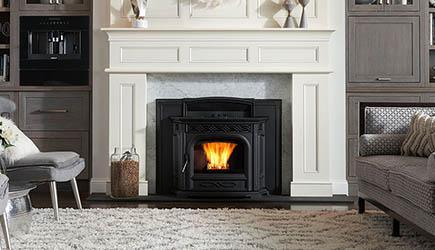
Why Pellet Inserts Are More Efficient Than Traditional Fireplaces

Since the dawn of man, wood has been used as a fuel for heat and for cooking. Traditionally, homes were built around a stone or brick hearth located in the center of the home. During the winter these hearths were always kept burning, which would result in the masonry radiating heat throughout the home. This type of heating was very inefficient by today’s standards, and required enormous amounts of firewood. In a little bit of American History, Benjamin Franklin made great advances in hearth design and construction, patented over 35 different heating designs, and even has a fireplace created in his namesake: the “Franklin Fireplace”, it is still made in some fashion or another even today.
Modern homes created in the 20th century may still have open fireplaces designed to burn wood, but the heating efficiency in many ways is even worse than it may have been 300 years ago, this is due to a few reasons. Modern fireplaces are not located centrally in the home, they are not sized adequately for heating requirements, and they are not built for heating retention like they were long ago when the hearth was the only source of heat.
It’s not uncommon for a fireplace built in a 1980’s home to register a 9-15% efficiency rating, this is a very low number. There are two reasons the efficiency rating is so low; fireplaces were being built into the exterior of homes, and the other has to do with combustion airflow. Fire requires oxygen (air) to sustain combustion, and fireplaces take this air from within the home, which is often already heated. As you burn a fire in the fireplace the heat escapes up the flue, this causes more air to be sucked into the firebox. If the only exposed masonry of the fireplace is the fireplace itself…well, there’s no chance for the masonry to actually radiate heat back into the home. As the heated air in the home is sucked out of the house and up the flue, the cold air outside of the home is sucked into the house through cracks and gaps in the windows, doors and other poorly insulated areas, causing the house to actually cool down.
Modern pellet stove inserts can boast efficiency ratings of 75% or more. These have the ability to convert a fireplace (which is at best 15% efficient) and get it upwards of 80% by restricting combustion air flow. This helps optimize combustion and circulate room air through the appliances’ heat exchanger. If you are shopping around for a new pellet stove insert you may see EPA tags on newer models touting their tested efficiency. There are many different ways a pellet stove or insert can be efficient, but the efficiency these tags represent is the heat transfer efficiency, or simply; how much heat goes out the vent to the outdoors vs. how much heat stays inside the house.
Most of the homes that we install inserts into are taking advantage of a fireplace in an end room, bonus room, or family room scenario where it was seldom used simply because it’s too difficult to heat during the winter. Once a pellet stove is installed the space becomes not only warm, but functional again. If you have a fireplace in your home, installing a pellet stove insert really makes sense because you’re updating a very inefficient system without taking up any more space. If this article has you thinking of purchasing a pellet stove, you’ll want to read our article on the best pellet stoves here. Happy Heating!

Leave a comment